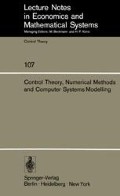Abstract
Linear stochastic control theory gives the potential to formulate and solve regulation problems for industrial processes in a fairly realistic manner. This has also been demonstrated in several applications, [1]. The use of the theory does, however, require mathematical models of the process and its disturbances. Models of the process dynamics can sometimes be obtained from physical laws. Modeling of the disturbances will almost always require experimental data from the process. To apply the theory it is thus necessary to perform plant experiments and to make a system identification.
Access this chapter
Tax calculation will be finalised at checkout
Purchases are for personal use only
Preview
Unable to display preview. Download preview PDF.
References
Aström, K. J., “Computer Control of a Paper Machine — an Application of Linear Stochastic Control Theory”, IBM J, Res. Dev. 11 (1967), 389–405.
Aström, K. J. and Wittenmark, B., “Problems of Identification and Control”, JMAA 34 (1971), 90–113.
Aström, K. J. and Wittenmark, B., “On Self-Tuning Regulators”, Automatica 9 (1973), 185–199.
Aström, K. J. and Wittenmark, B., “Analysis of a Self-Tuning Regulator for Nonminimum Phase Systems”, Submitted to IFAC Symposium on Stochastic Control Theory, Budapest 1974.
Bohlin, T., “Optimal Dual Control of a Simple Process with Unknown Gain”, Report TP 18.196, IBM Systems Development Division Nordic Laboratory, Sweden 1969.
Borisson, U. and Wittenmark, B., “An Industrial Application of a Self-Tuning Regulator”, 4th IFAC Conference on Digital Computer Applications to Process Control, Zürich 1974.
Borisson, U. and Syding, R., “Self-Tuning Control of an Ore Crusher”, IFAC Symposium on Stochastic Control Theory, Budapest 1974.
Cegrell, T. and Hedqvist, T., “Successful Adaptive Control of Paper Machines”, 3rd IFAC Symposium on Identification and System Parameter Estimation, Hague 1973.
Gustavsson, I. Ljung, L. and Söderström, T., “Identification of Linear, Multivariable Process Dynamics Using Closed Loop Estimation”, Report 7401, Division of Automatic Control, Lund Institute of Technology, 1974.
Kaiman, R. E., Design of a Self-Optimizing Control System”, Trans ASME 80 (1958) also in Oldenburger, R. (Ed.) Optimal Self-Optimizing Control MIT Press 1966, 440–449.
Landau, I. D., “Model Reference Adaptive Systems — A Survey (MRAS) — What is possible and Why?”, ASME J. of Dynamic Systems, Measurement and Control (1972), 119–132.
Ljung, L., “Convergence of Recursive Stochastic Algorithms”, Report 7403, Division of Automatic Control, Lund Institute of Technology, 1974.
Ljung, L. and Wittenmark, B., “Asymptotic Properties of Self-Tuning Regulators”, Report 7404, Division of Automatic Control, Lund Institute of Technology, 1974.
Ljung, L., “Stochastic Convergence of Algorithms for Identification and Adaptive Control”, Thesis for teknologie doktorsexamen, Lund Institute of Technology, Lund 1973.
Peterka, V., Adaptive Digital Regulation of a Noisy System”, 2nd IFAC Symposium on Identification and Process Parameter Estimation, Prague 1970, paper No. 6.2.
Peterka, V. and Aström, K. J., “Control of Multivariable Systems with Unknown but Constant Parameters”, 3rd IFAC Symposium on Identification and System Parameter Estimation, Hague 1973.
Wieslander, J. and Wittenmark, B., “An Approach to Adaptive Control Using Real Time Identification, Automatica 7 (1971), 211–217.
Wittenmark, B. “A Self-Tuning Regulator”, Report 7311, Division of Automatic Control, Lund Institute of Technology, Lund, Sweden, April 1973.
Wittenmark, B., “Self-Tuning Regulator”, Thesis for teknologie doktorsexamen, Lund Institute of Technology, 1973 (also Report 7 312, Division of Automatic Control, Lund Institute of Technology 1973.
Young, P., “An Extension of the Instrumental Variable Method for Identification of A Noisy Dynamic Process”, Report CN/70/1, University of Cambridge, Dept. of Eng.
Author information
Authors and Affiliations
Editor information
Editors and Affiliations
Rights and permissions
Copyright information
© 1975 Springer-Verlag Berlin · Heidelberg
About this paper
Cite this paper
Åström, K.J. (1975). Theory and Applications of Self-Tuning Regulators. In: Bensoussan, A., Lions, J.L. (eds) Control Theory, Numerical Methods and Computer Systems Modelling. Lecture Notes in Economics and Mathematical Systems, vol 107. Springer, Berlin, Heidelberg. https://doi.org/10.1007/978-3-642-46317-4_45
Download citation
DOI: https://doi.org/10.1007/978-3-642-46317-4_45
Publisher Name: Springer, Berlin, Heidelberg
Print ISBN: 978-3-540-07020-7
Online ISBN: 978-3-642-46317-4
eBook Packages: Springer Book Archive

